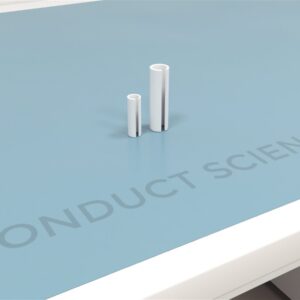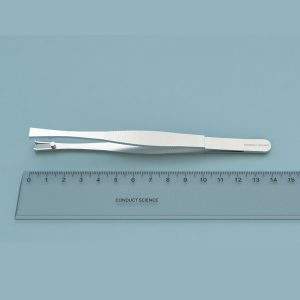The Isolated perfused lung system for mice is a set of core products that facilitates ex vivo lung perfusion (EVLP) in fragile mouse lungs for ventilation and perfusion experiments.
The system uses positive or negative pressure ventilation to perfuse the lung placed in the chamber. The procedure involves cannulation of the pulmonary artery and the left atrium. One lung is placed in the chamber under artificial thoracic pressure, whereas the other non-functional lung remains in the thoracic cavity.
The purpose of this system is to keep the lung in physiological conditions for organ transplantation or other respiration-based experiments.
ConductScience offers the isolated perfused lung system for mice.
AfaSci, Inc. is a biopharmaceutical company focused on discovering and developing innovative therapies for pain management and neurological disorders. Based in the San Francisco Bay Area, AfaSci specializes in non-opioid, non-NSAID solutions to address chronic pain, neuropathic conditions, and central nervous system diseases. Their research is centered around peptide and small molecule drugs, with several promising preclinical candidates targeting specific ion channels and enzymes involved in pain and inflammation. With a strong intellectual property portfolio and strategic partnerships with academic institutions, AfaSci is dedicated to advancing novel treatments that aim to improve patients' quality of life while reducing reliance on traditional painkillers.



bool(false)
An isolated perfused lung system for mice is a set of core products that facilitates ex vivo lung perfusion (EVLP) in fragile mouse lungs for ventilation and perfusion experiments. The system uses positive or negative pressure ventilation to perfuse the lung placed in the chamber. The procedure involves cannulation of the pulmonary artery and the left atrium. One lung is placed in the chamber under artificial thoracic pressure, whereas the other non-functional lung remains in the thoracic cavity. The purpose of this system is to keep the lung in physiological conditions for organ transplantation or other respiration-based experiments. An isolated perfused lung system for mice is used to measure respiratory mechanics and conduct drug and toxicology experiments on respiratory and vascular parameters.
The basic principle of ex vivo lung perfusion (EVLP) is to keep lungs in a viable state outside the animal’s body by perfusing them with a relevant perfusion buffer (perfusate). During the perfusion experiments, the animal’s pulmonary artery is cannulated. The perfusate is pumped through a roller pump at constant flow or pressure. As a result, the perfusion buffer passes through the heat exchanger to the pulmonary artery and then finally enters the lung vascular bed. The heart’s left atrium is cannulated to facilitate the effluent outflow. On the other hand, the non-functional lung is kept in the thoracic cavity, enabling easier cannula placement for the outflow of the perfusate.
Apart from perfusion, an isolated perfused lung system for mice can also be employed for ventilation experiments. The researcher can choose between positive and negative pressure ventilation. Positive pressure ventilation is used in experiments that imitate clinical EVLP systems. Due to substantial difference in vascular flow rates, sub-atmospheric pressure ventilation allow the researchers to establish ex vivo conditions quite close to the in vivo physiological conditions. In such experiments, the lung is placed in the chamber and can be ventilated using artificial thoracic pressure. This pressure can be positive or negative.
An isolated perfused lung system for mice comprises a moist lung chamber with an integrated heat exchanger and a bubble trap. The chamber is completely water-jacketed for accurate temperature monitoring and possesses a lid. Pressure balancing during ventilation experiments is achieved by a pressure-balancing vessel that eliminates transmural pressure difference. Additional options can be attached to the basic isolated lung perfusion system. For instance, the lung can be connected via a tracheal cannula to the pneumotachometer for measuring respiratory airflow. A ventilation control module (VCM) can be used to adjust respiration rate, and inspiratory, and end-expiratory pressure.
The basic unit of isolated perfused lung system offered by Conduct Science includes a negative pressure lung chamber, i.e., the “artificial thorax” with lid and Venturi jet, positive pressure ventilation head, connectors, pneumotachometer, air humidifier, pressure balancing vessel, and stainless steel tracheal, pulmonary, and atrial cannulas for the mouse. The internal diameter (ID) and outer diameter (OD) of these cannulas are listed below:
Conduct Science also offers isolated perfused lung systems for other animals like rats, guinea pigs, and large rodents.
Ventilation
Perfusion
The isolated perused lung system has manifold applications. Scientists use it to measure respiratory parameters like respiration rate, respiratory airflow, pulmonary artery pressure, intrapleural/tracheal pressure, and vascular resistance. The system is widely employed to assess the effect of drugs and toxins on respiration and vascular parameters. Out of several applications of isolated perfused lung systems for mice in perfusion and ventilation experiments, some are presented below.
IRI Diagnosis in Lung Transplantation
Charles et al. (2020) studied how ischemia-reperfusion injury (IRI) is responsible for primary graft dysfunction. They used [99mTc]cFLFLF, a ligand of formyl peptide receptor 1 (FPR1), for the molecular targeting of FPR1 to perform SPECT imaging of IRI. The researchers used an isolated perfused long system for mouse to assess the combined function of right and left lungs after reperfusion. They anesthetized 9-12 weeks old C57BL/6 wild-type mice using ketamine-xylazine and then performed tracheotomy for tracheal cannulation. Following this, they ventilated the animal at a tidal volume of 7μL/g and a rate of 100 breaths per minute using 2 cmH2O positive end-expiratory pressure. They later exsanguinated via transection of the abdominal aorta and inferior vena cava. Later, the investigators cannulated the pulmonary artery and perfused the lungs using Krebs- Henseleit buffer warmed to 37oC and finally performed left ventriculotomy to facilitate the perfusate outflow. After 5 minutes pressure equilibration period, the data was collected using PULMODYN software. Then, the experimenters performed SPECT imaging and concluded that [99mTc]cFLFLF SPECT aids in non-invasive IRI diagnosis for timely intervention to improve lung transplantation outcomes.
Assessment of Airway Hyperresponsiveness
Tartaglione et al. (2018) the role of Nociceptin/orphanin Fq (N/OFQ) in inflammation and remodeling of small airways in murine models of airway hyperresponsiveness. The researchers took 6 weeks old female BALB/c mice and divided them into six groups including naïve, OVA alone (administered with allergen ovalbumin), N/OFQ alone, pre-OVA sensitized (i.p., administration of N/OFQ before OVA injection), post-OVA sensitized (OVA injection followed by N/OFQ administration). The experimenters used an isolated perfused lung system to determine airway hyperresponsiveness. They anesthetized the mice intraperitoneally and administered 40mg/kg ketamine HCl and 0.15mg/kg medetomidine hydrochloride. Following this, they incised the skin from the abdomen to the throat, thereby exposing the trachea, and cannulated it. Later, they incised the diaphragm to expose the heart and injected 50µl heparin. Then the investigators exsanguinated the mouse following renal vena incision and cut open the thorax. Two thoracic halves were fixed at the sides using two cannulas. They also cannulated PA and administered the drugs through the cannula into the pulmonary artery.
After this, they perfused the lungs in a non-circulating fashion via the PA at 1ml/min., resulting in a pressure of 1cmH2O. The perfusion buffer was RPMI 1640 medium without phenol red warmed to 37oC containing 4% low endotoxin grade albumin. The scientists ventilated the lungs at a negative pressure of -3 to -9 cmH2O with a tidal volume of 200μl and 90breaths/min. They used a pressure balancing vessel to measure pressure in the artificial thorax chamber and a pneumotachometer to measure airflow velocity. The lungs respired humidified air, and a pressure transducer was used to monitor arterial pressure constantly. All data was processed through PULMODYN software. The results suggested that N/OFQ protects against inflammation and remodeling in airway hyperresponsiveness.
An isolated perfused lung system for mice has several advantages. The foremost advantage of this system is that it allows researchers to study the effects of drugs and respiratory mechanics outside the body in near-physiological conditions without the influence of other body systems. The advantage of using small animal models like mice for EVLP is that they are budget friendly compared to isolated perfused lung systems for larger animals. The smaller initial cost means one can perform more perfusion experiments in less time and less money. Moreover, murine models have a better immune response as compared to rats. They have a greater number of species-specific antibodies and a greater number of gene probes available for experiments (Nelson et al., 2014).
The artificial thorax chamber in an isolated perfused lung system for mice provides near physiological conditions to study mouse lungs. The apparatus provides a quick switch between positive and negative pressure ventilation, thus increasing the experimental versatility. Its integrated surgery table lowers the damage during preparation. The system is designed to minimize perfusion artifacts and offers low flow resistance. A built-in humidifier prevents the lungs from drying. However, a potential disadvantage of using murine models in isolated lung perfusion experiments is that mouse organs are quite small and challenging to handle.
| Brand | ConductScience |
|---|
You must be logged in to post a review.
There are no questions yet. Be the first to ask a question about this product.
Reviews
There are no reviews yet.